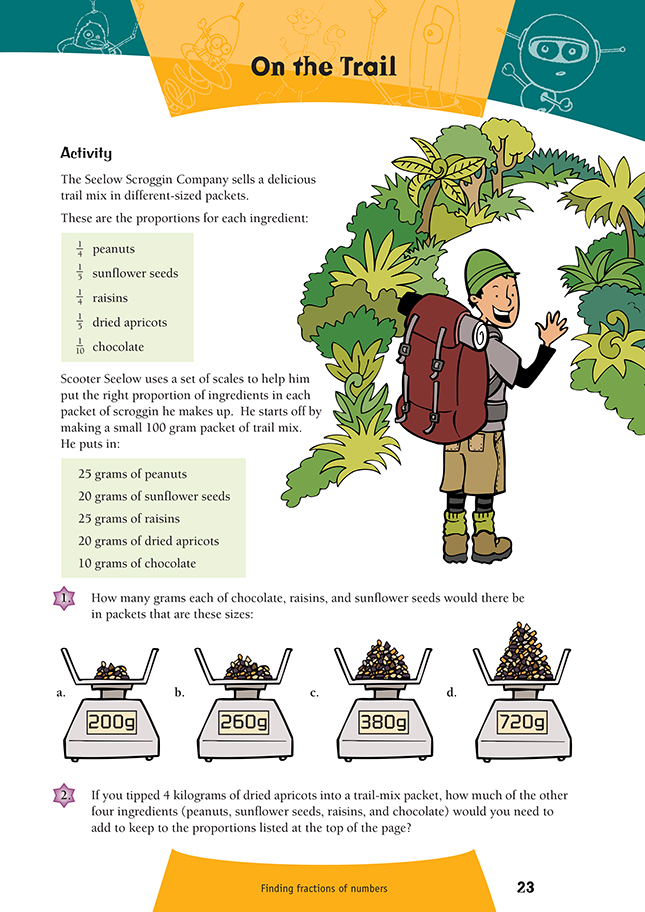This is a level 3 number activity from the Figure It Out series. It relates to Stage 6 of the Number Framework.
A PDF of the student activity is available.
Click on the image to enlarge it. Click again to close. Download PDF (361 KB)
find fractions of whole numbers
FIO, Level 3, Number, Book 2, On the Trail, page 23
This activity allows the students a choice of strategies as they tackle these fraction problems. The keys to choosing a strategy are the relationships between the amounts of the ingredients and the connections between the different amounts of trail mix. The students could explore these connections in groups of four and report back to the class.
A ratio table would help the students to see the connection between the proportion of the ingredients and how these match the amounts in each mix.
Ask the students to find connections in the table. They could make statements such as: “Peanuts and raisins have the same proportion, which is a quarter.” “Sunflower seeds and dried apricots have the same proportion, which is one-fifth.” “The chocolate is half the amount of the dried apricots.” “Peanuts and raisins make up half of the mix.”
Have the students check that the amounts of the ingredients make up the whole. That is, that 1/4 + 1/5 + 1/4 + 1/5 + 1/10 = 1. A double number line with 20 divisions may be useful to show this:
Another way of showing this is to have the amounts of each ingredient shown as blocks along the number line:
Have the students explore some strategies for the addition of the parts using numbers. They may see that 1/4 + 1/4 = 1/2 and 1/5 + 1/5 + 1/10 = 1/2 and 1/2 + 1/2 = 1.
If they choose the common denominator of 20 and convert all the fractions to this, they will get 5/20 + 5/20 + 4/20 + 4/20 + 2/20 = 1, which is an equivalent expression for the relationships.
You can now ask the students to try and use these connections to help them solve the problems. Discuss the strategies they use.
Multiplicative thinkers may see that question 1a uses an amount that is 2 times that of the sample Scooter has already made. Question 1b can be seen as either 2.6 times greater than Scooter’s 100 gram sample or 1.3 times the answer to 1a. The students could continue these strategies for the other questions.
Additive thinkers may solve 1a by doing repeated addition of each amount.
In question 2, the students could relate the new quantities of apricots to the ratio table at the beginning. They may see that it is just double the number and a change of unit from grams to kilograms. They can then use this table or make another ratio table to solve the problem.
Answers to Activity
1. a. 20 g chocolate, 50 g raisins, 40 g sunflower seeds
b. 26 g chocolate, 65 g raisins, 52 g sunflower seeds
c. 38 g chocolate, 95 g raisins, 76 g sunflower seeds
d. 72 g chocolate, 180 g raisins, 144 g sunflower seeds
2. 5 kg peanuts, 4 kg sunflower seeds, 5 kg raisins, 2 kg chocolate



